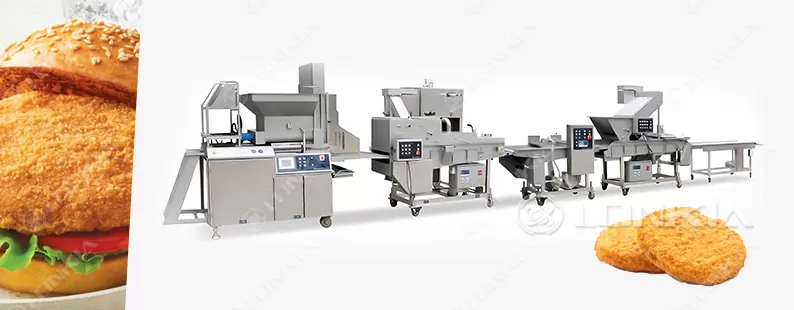Producing hamburger patties in an industrial setting involves a series of steps designed to ensure quality, consistency, and safety. In this article, we’ll walk through each stage of the hamburger patty production process, from meat selection to packaging, highlighting the importance of precision and quality control.
1. Meat Selection and Preparation
High-quality beef, pork, or other meats are chosen based on desired taste, texture, and fat content. The fat-to-lean ratio is important as it affects flavor and juiciness, with an ideal range often around 80/20 (80% lean meat, 20% fat).
The selected meat is thoroughly inspected and trimmed to remove any undesired fats, cartilage, or bones, ensuring a smooth texture for the patties.

2. Grinding the Meat
The trimmed meat is fed through a grinder machine to achieve a specific texture. The grind size can vary depending on the type of burger, but most commercial patties are ground to a medium consistency, giving them a satisfying bite and juicy texture.
Cold temperatures are maintained during this step to prevent bacterial growth and ensure product freshness.
3. Mixing and Seasoning
Once ground, the meat is mixed with seasoning and additional ingredients. Common seasonings include salt and pepper, while other additives or binding agents can be included based on specific recipes.
High-quality meat mixer machines ensure that the seasonings are evenly distributed throughout the meat, providing consistent flavor in each patty.
4. Shaping and Forming Patties
The seasoned meat mixture is then fed into a patty-forming machine, where it is shaped into individual patties of uniform size and weight. Patty size can vary, but most machines can produce different diameters and thicknesses to meet diverse market demands.
Automated forming ensures consistent shape and size, making it easier to cook evenly and package efficiently.
5. Cooking and Freezing (Optional)
Some hamburger patties are cooked partially or fully before freezing, especially if they’re intended for quick-service restaurants or ready-to-eat meals. Cooking at this stage ensures the patty reaches a safe temperature to eliminate bacteria.
Immediately after forming or cooking, patties are quickly frozen using a blast freezer. Rapid freezing helps lock in freshness, texture, and flavor while extending the product’s shelf life.
6. Packaging
Frozen patties are then packaged in vacuum-sealed or modified-atmosphere packaging (MAP) to prevent freezer burn and maintain freshness. These packaging methods provide an airtight seal, ensuring long-lasting quality during storage and transportation.
Packaging labels typically include important product information such as ingredients, weight, expiration dates, and cooking instructions.

7. Quality Control and Distribution
Throughout each step, quality control checks are conducted to monitor the taste, texture, and safety of the product. Rigorous testing helps to maintain consistent quality, ensuring that each batch meets regulatory and company standards.
The packaged patties are stored in refrigerated or frozen conditions and distributed to grocery stores, restaurants, or directly to consumers.
The production process of hamburger patties involves careful attention to detail, from selecting quality meat to ensuring uniformity in size and flavor. At LONKIA, we provide state-of-the-art equipment for every stage of the process, from grinding and forming to freezing and packaging, helping manufacturers achieve reliable, efficient, and high-quality production results.
At LONKIA, we offer a wide range of equipment and solutions to help you streamline your hamburger patty production process and ensure that your products are of the highest quality. Contact us today to learn more about how we can help you take your hamburger patty production to the next level.
